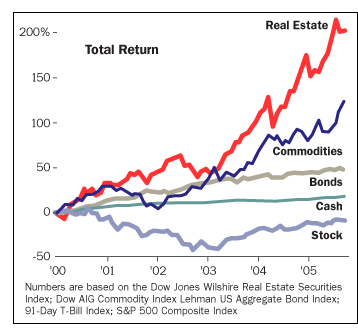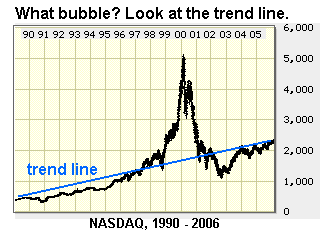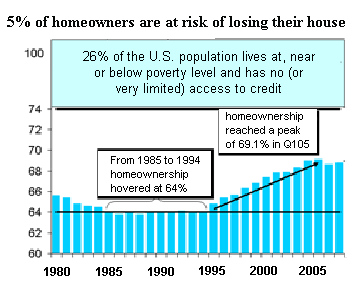

|
| weblog/wEssays archives | home | |
|
After the Bubble: How Low Will We Go, Part II (May 18, 2006)  My May 15 entry,
After the Bubble: How Low Will It Go? drew several thoughtful
and well-argued critiques. Interestingly, neither
correspondent disputed the housing bubble--they only contested the severity of the drop.
Fair enough; I think each makes valid refinements to my simple calculations.
But it's also possible that the drop will actually be worse than I projected.
My May 15 entry,
After the Bubble: How Low Will It Go? drew several thoughtful
and well-argued critiques. Interestingly, neither
correspondent disputed the housing bubble--they only contested the severity of the drop.
Fair enough; I think each makes valid refinements to my simple calculations.
But it's also possible that the drop will actually be worse than I projected.
The first analyst, Robert C., notes that my straight line did not accurately reflect the fact that prices fluctuate above and below the trendline--an excellent point: "What I wish you to consider however is the 1% Shiller number and inflation. When you draw a straight line from 1986 you ignore both. Shiller does not and there is another issue. Inflation indicies since 1986 have been adjusted downward 3 times. Taken into account your straight line then curves up at a compound 1% on top of inflation at the old measure not the new one. OKAY, big deal. We are still on the same page but I see prices only 1.8x trendline while you are showing 2.3x overvaluations. Of course if you look again at your graph and adjust for my "corrections" you see c1970 and c1995 as periods of some undervaluation which in the fullness of time seems reasonable does it not? We come back together at the end because ultimately we need to dip below trend to return to trend. So, your return to norm is my bottom of the market." (emphasis added)Next up is a well-argued refinement of my calculations: "1. 20 years of 1% increment is not 20%. Its 1.01 times 1.01 20 times and minus 1. Thats roughly 22%.  Let's look at these assumptions more closely. While it's true that the last housing cycle
took six years to decline, it was not a bubble. Bubbles tend to fall as quickly as they rise.
The chart to the right illustrates the dot-com era Nasdaq. While this is a stock market,
the first chart reveals that the current real estate bubble inflated rapidly from 2003 through
mid-2005--a mere 2.5 years.
Let's look at these assumptions more closely. While it's true that the last housing cycle
took six years to decline, it was not a bubble. Bubbles tend to fall as quickly as they rise.
The chart to the right illustrates the dot-com era Nasdaq. While this is a stock market,
the first chart reveals that the current real estate bubble inflated rapidly from 2003 through
mid-2005--a mere 2.5 years.
Given the unprecedented level of excess in today's housing bubble, it is likely that the bubble will deflate as quickly as it rose. This would mean the majority of today's gains might evaporate in a little as 2 years. And as my first correspondent noted, markets fluctuate below the trendline after an extended period above the trendline--a behavior clearly visible in the chart of the Nasdaq bubble. In other words, the housing market is likely to fall well below the trendline in the initial post-bubble decline. Thus, while my second correspondent argues quite effectively for a "reversion to the trendline" number of $355,000, rather than my figure of $315,000, history suggests trendlines are broken to the downside as the bubble pops. This is a strong argument in favor of my original projection that housing prices will have to fall over 50% before reaching bottom. If prices fall fast, the effects of inflation will have little effect. If the median price of a S.F. Bay Area home falls from $715,000 to "only" $355,000 rather than to $315,000, will anyone's financial ruination be prevented? No. Next up: inflation. My second correspondent suggests that if the dollar falls in value, this will trigger inflation which will act to inflate property values. This sounds very reasonable, and here's why: But wait. If mortgage rates rise to 13%, who can afford to pay $700,000 for a house? That's the gotcha. No one can. That's the flaw in the idea that higher inflation will support housing prices. To keep inflation from accelerating out of control, Paul Volker and President Reagan raised interest rates to 15%, effectively ending all lending for autos and houses. The automakers, unable to sell cars with cheap loans, laid off hundreds of thousands of workers and lost billions. Home building dried up and blew away, as did real estate sales--who could qualify for a mortgage at 15%?--and of course, housing values sank, too. It was called "stagflation": stagnant economy, wages and employment coupled with high inflation. The "medicine" is high interest rates, which causes housing to drop back to what is affordable. Care to know what a $600,000 mortgage costs at 13% interest? Try $6,637 per month on a 30-year fixed mortgage. How many people can afford that? As I have noted here before: housing prices are correlated to the interest rate--period. If interest rates double from 5% to 10%, then housing will drop by 50% because people can only afford to pay so much for housing. You can finesse all kinds of numbers, but it all comes back to affordability. Once interest rates rise, housing necessarily plummets beause there are simply no buyers who can afford the inflated prices. I don't want to get too technical here, but there's also a fatal flaw in the idea that the dollar will drop through the floor. If euro banks are paying 4.5% and U.S. Treasuries are paying 9%, which one are you going to buy? The Treasuries, of course--and in so doing, you'll be buying dollars--which guess what, puts upward pressure on the value of the dollar. So as interest rates rise in the U.S. due to inflation, the dollar may well rise rather than fall. So we may well get deflating housing and appreciating currency at the same time.  Three other realities will send house prices plummeting to below-trendline levels: the
complete lack of buyers, oversupply of housing due to foreclosures and the loss of jobs.
As this chart reveals, virtually everyone who isn't poverty-stricken or in prison already
owns a house. As foreclosures rise (see
patrick.net for the latest news on foreclosure rates rising dramatically) then the current
oversupply of homes will climb to unprecedented heights--an ascent which will be accelerated by
massive job losses in the housing sector, which as CNN reports below, is fully 20%-25% of the
entire $12 trillion U.S. economy.
Housing slowdown to be widely felt:
Three other realities will send house prices plummeting to below-trendline levels: the
complete lack of buyers, oversupply of housing due to foreclosures and the loss of jobs.
As this chart reveals, virtually everyone who isn't poverty-stricken or in prison already
owns a house. As foreclosures rise (see
patrick.net for the latest news on foreclosure rates rising dramatically) then the current
oversupply of homes will climb to unprecedented heights--an ascent which will be accelerated by
massive job losses in the housing sector, which as CNN reports below, is fully 20%-25% of the
entire $12 trillion U.S. economy.
Housing slowdown to be widely felt:
"Housing accounts for between a fourth and a fifth of the GDP (gross domestic product)," said Walter Molony, spokesman for the National Association of Realtors, referring to the broad measure of the nation's economic activity. "So many other industries see sales tied to the purchase of a home. We get calls from Singer sewing machines about our home sales statistics."If the industry itself is predicting a direct job loss of 375,000--never mind the furniture salepeople, countertop manufacturers, and all the other millions of people indirectly employed by the housing industry--then you can bet the reality will be much worse. So take your pick: a decline in median house prices from $715,000 down to "only" $350,000 or a slightly more severe drop to $315,000. Will it really make any difference? Sadly, probably not. For more on this subject and a wide array of other topics, please visit my weblog. copyright © 2006 Charles Hugh Smith. All rights reserved in all media. I would be honored if you linked this wEssay to your site, or printed a copy for your own use. |
||
| weblog/wEssays | home |